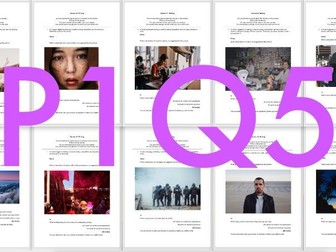AQA English Language Paper 1: Question 5 Practice Questions x 10
One professional-quality word document containing Ten practice/example questions for GCSE English Language Paper 1 Question 5 (Section B - Writing). Each question has a prompt image with two creative writing options (usually a description and a story).
An excellent resource for:
teaching the key skills required for planning a response to P1 Q5;
embedding writer methods in descriptive writing;
using as practice tests for students;
preparing students for the layout and wording used in AQA exam papers.
The images have been selected so that they reflect the compositional variety of the new AQA spec. E.g. landscapes, facial close-ups, items on shelves and candid scenes of people. They’re all inspiring in their own way, and some will be more challenging than others.
The wording is also varied for each question so that they reflect the variety of different questions posed in all AQA papers from June 2017 to present. Please note: file 05 contains two story-writing tasks so that teachers can prepare students for this eventuality (see AQA Nov 2017 paper).
Please rate, leave a review and let me know if I could make any improvements!
Thanks,
Adam

